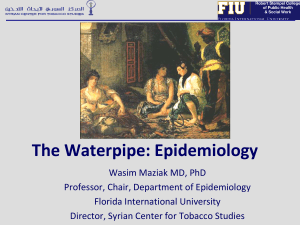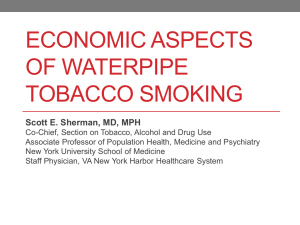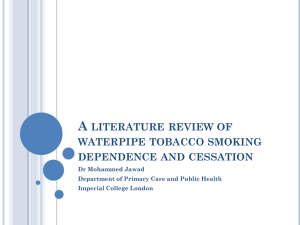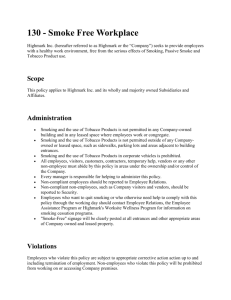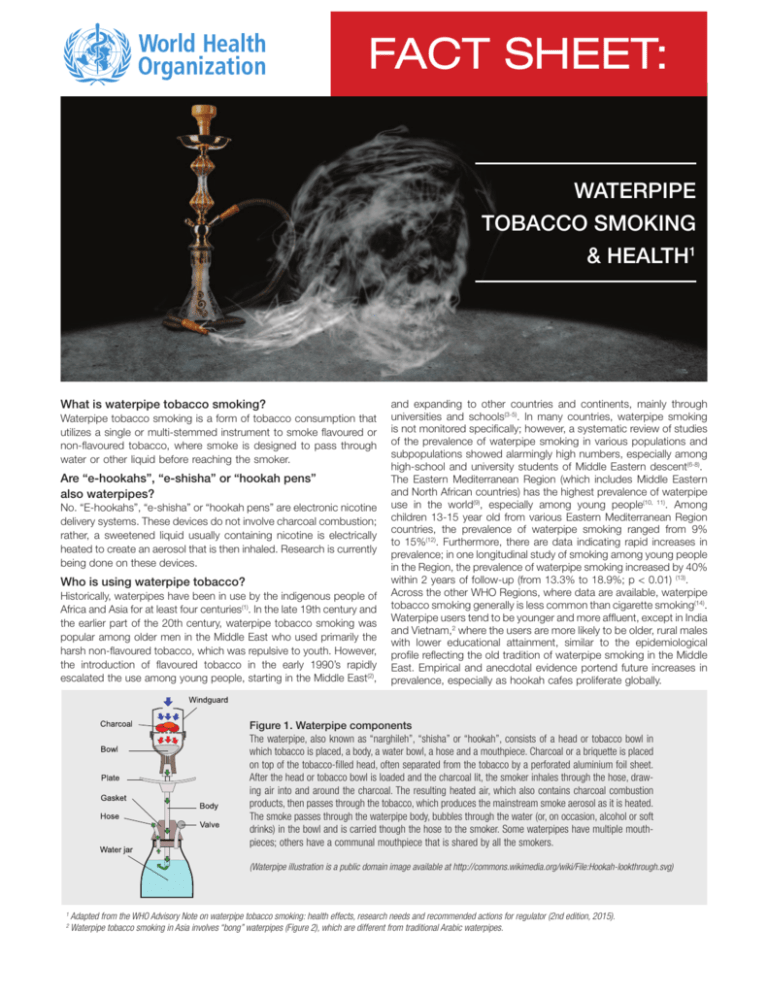
FACT SHEET:
WATERPIPE
TOBACCO SMOKING
& HEALTH1
What is waterpipe tobacco smoking?
Waterpipe tobacco smoking is a form of tobacco consumption that
utilizes a single or multi-stemmed instrument to smoke flavoured or
non-flavoured tobacco, where smoke is designed to pass through
water or other liquid before reaching the smoker.
Are “e-hookahs”, “e-shisha” or “hookah pens”
also waterpipes?
No. “E-hookahs”, “e-shisha” or “hookah pens” are electronic nicotine
delivery systems. These devices do not involve charcoal combustion;
rather, a sweetened liquid usually containing nicotine is electrically
heated to create an aerosol that is then inhaled. Research is currently
being done on these devices.
Who is using waterpipe tobacco?
Historically, waterpipes have been in use by the indigenous people of
Africa and Asia for at least four centuries(1). In the late 19th century and
the earlier part of the 20th century, waterpipe tobacco smoking was
popular among older men in the Middle East who used primarily the
harsh non-flavoured tobacco, which was repulsive to youth. However,
the introduction of flavoured tobacco in the early 1990’s rapidly
escalated the use among young people, starting in the Middle East(2),
and expanding to other countries and continents, mainly through
universities and schools(3-5). In many countries, waterpipe smoking
is not monitored specifically; however, a systematic review of studies
of the prevalence of waterpipe smoking in various populations and
subpopulations showed alarmingly high numbers, especially among
high-school and university students of Middle Eastern descent(6-8).
The Eastern Mediterranean Region (which includes Middle Eastern
and North African countries) has the highest prevalence of waterpipe
use in the world(9), especially among young people(10, 11). Among
children 13-15 year old from various Eastern Mediterranean Region
countries, the prevalence of waterpipe smoking ranged from 9%
to 15%(12). Furthermore, there are data indicating rapid increases in
prevalence; in one longitudinal study of smoking among young people
in the Region, the prevalence of waterpipe smoking increased by 40%
within 2 years of follow-up (from 13.3% to 18.9%; p < 0.01) (13).
Across the other WHO Regions, where data are available, waterpipe
tobacco smoking generally is less common than cigarette smoking(14).
Waterpipe users tend to be younger and more affluent, except in India
and Vietnam,2 where the users are more likely to be older, rural males
with lower educational attainment, similar to the epidemiological
profile reflecting the old tradition of waterpipe smoking in the Middle
East. Empirical and anecdotal evidence portend future increases in
prevalence, especially as hookah cafes proliferate globally.
Figure 1. Waterpipe components
The waterpipe, also known as “narghileh”, “shisha” or “hookah”, consists of a head or tobacco bowl in
which tobacco is placed, a body, a water bowl, a hose and a mouthpiece. Charcoal or a briquette is placed
on top of the tobacco-filled head, often separated from the tobacco by a perforated aluminium foil sheet.
After the head or tobacco bowl is loaded and the charcoal lit, the smoker inhales through the hose, drawing air into and around the charcoal. The resulting heated air, which also contains charcoal combustion
products, then passes through the tobacco, which produces the mainstream smoke aerosol as it is heated.
The smoke passes through the waterpipe body, bubbles through the water (or, on occasion, alcohol or soft
drinks) in the bowl and is carried though the hose to the smoker. Some waterpipes have multiple mouthpieces; others have a communal mouthpiece that is shared by all the smokers.
(Waterpipe illustration is a public domain image available at http://commons.wikimedia.org/wiki/File:Hookah-lookthrough.svg)
1
2
Adapted from the WHO Advisory Note on waterpipe tobacco smoking: health effects, research needs and recommended actions for regulator (2nd edition, 2015).
Waterpipe tobacco smoking in Asia involves “bong” waterpipes (Figure 2), which are different from traditional Arabic waterpipes.
Is waterpipe tobacco smoking dangerous to health?
MIDDLE-EAST WATERPIPE
Head /
Tobacco Bowl
Body
CHINESE BONG
Clay Bowl to
Hold Tobacco
Wooden Stem
Water Bowl
Wooden smoking tube
Mouthpiece
Coconut Shell
Water Receptacle
Figure 2. Comparison between Asian “bong” waterpipe
and the Middle Eastern waterpipe
Source: World Health Organization, 2015
Why is waterpipe tobacco smoking becoming more
popular, especially among young people?
Some of the distinctive factors that appear to contribute to the
growing popularity of waterpipe tobacco smoking include:
1. Introduction of flavoured tobacco (maassel) - The introduction
of sweetened flavoured waterpipe tobacco, commonly called
maassel, in the 1990’s appears temporally related to the surge
in popularity of waterpipe smoking(15). Previous to maassel,
waterpipe smokers used raw tobacco in their pipes. The strong
and harsh smoke from raw tobacco contrasts markedly with
the smooth aromatic smoke produced from maassel. Maassel
comes in many flavours and simplifies waterpipe preparation(16).
Global data indicate that most waterpipe smokers, particularly
the young users, prefer maassel for use in waterpipes(17-19).
2. Social acceptability due to the café and restaurant culture
– Sharing a waterpipe is a widespread practice, especially
among young people(16, 17, 20), and cafés and restaurants have
capitalized on this by incorporating waterpipes into their menu
of services. The “Ramadan tents” in the 1990s were a special
form of café that provided a social venue during the Muslim holy
month of Ramadan(21). Waterpipes became the centrepieces
of these settings, legitimizing their use in social gatherings.
Waterpipe cafés and restaurants are proliferating around the
world, fostering this form of tobacco consumption(20, 22, 23).
3. Promotion through mass communication and social media
– Traditional and new media and the Internet are devoting
increasing air time to waterpipe tobacco smoking, often
depicting the practice in a positive way. One analysis of
cigarette- and waterpipe-related YouTube videos showed that
user-generated videos of waterpipe use were less likely to
acknowledge the negative health consequences of smoking
than cigarette videos(24). In addition, marketers and vendors of
waterpipe and waterpipe tobacco are using the Internet and
social media to advertise their products in the guise of blogs
and postings by interest groups(25).
4. Lack of waterpipe-specific policy and regulations – Waterpipe
products and venues are often exempt from tobacco control
policies; where policies exist, especially in the developing world,
the lack of enforcement renders waterpipe-related policies
ineffective(26, 27).
5. Erroneous perceptions about the relative safety of waterpipe
smoking – The belief that drawing tobacco smoke through water
makes waterpipe smoking less harmful than cigarette smoking
is widespread, and contributes to its growing popularity and
acceptability(28).
• Waterpipe smoke is toxic. Laboratory analyses of waterpipe
smoke reveal measurable levels of carcinogens (including tobacco-specific nitrosamines, polycyclic aromatic hydrocarbons
[PAH], volatile aldehydes like formaldehyde, and benzene), and
toxicants such as nitric oxide and heavy metals. Additionally,
the burning charcoal generates high levels of carbon monoxide (CO) and carcinogenic PAH(29). These toxic substances have
been linked to addiction, heart and lung diseases, and cancer
in cigarette smokers and can result in similar outcomes in waterpipe users if these toxicants are absorbed in the body in appreciable amounts(30).
• Waterpipe smokers absorb toxicants and carcinogens in
waterpipe smoke in appreciable amounts. Data from biomarker assays that measure toxicant and carcinogen levels in
the blood and urine of users demonstrate that waterpipe smoking results in significant exposure to these compounds. Waterpipe smokers have much greater exposure to CO, significantly
greater exposure to PAH, similar exposure to nicotine and significantly lower exposure to tobacco-specific nitrosamines than
cigarette smokers(31, 32).
• Waterpipe smoking results in measureable acute adverse
physiological and health effects. Studies document elevated
heart rate and blood pressure, other deleterious acute cardiovascular effects, impaired lung function and exercise capacity,
increased lung inflammation, syncope and acute CO poisoning
in waterpipe smokers(33-38).
• Waterpipe smoking is associated with multiple long-term
adverse health outcomes. Systematic reviews of existing
research point to significant associations between waterpipe
smoking and lung cancer, periodontal disease and low birth
weight (39). More recent data suggest probable associations
with oral, oesophageal, gastric and urinary bladder cancer, as
well as chronic obstructive pulmonary disease, cardiovascular
disease, stroke, chronic rhinitis, male infertility, gastro-oesophageal reflux and impaired mental health(40-67).
Is waterpipe tobacco smoking addictive?
The data indicate that waterpipe smoking is addictive. Nicotine is
the addictive substance in tobacco, and it is present in significant
quantities in waterpipe smoke. Waterpipe users have demonstrable
increases in plasma nicotine levels after waterpipe smoking, and exhibit behavioral symptoms of nicotine dependence(68-73). While many
of the indicators of waterpipe dependence are seen with cigarette
smoking, there are strong reasons to believe that tobacco dependence in waterpipe smokers has unique features that continue to be
unrecognized in models and instruments derived from the literature
on cigarettes(28). In the absence of an established and validated set of
waterpipe-specific measures of tobacco dependence, the addictiveness of the waterpipe may be currently underestimated.
What about second hand smoke from waterpipe tobacco
smoking?
Second hand smoke from waterpipes is harmful. Multiple studies
have documented the presence of significant quantities of CO, aldehydes, PAH, ultrafine particles and respirable particulate matter
in second hand waterpipe smoke(74-78). Waterpipe smoking results
in higher emissions of CO, PAH and volatile aldehydes than cigarette smoking(79). Moreover, the direct emissions of toxicants from
waterpipes smoked with a tobacco-free preparation were equal to
or greater than those from waterpipes smoked with tobacco-based
preparations. Thus, smoke from tobacco-free waterpipe products is
dangerous, and except for nicotine, has the same toxicant content
and biological activity as tobacco-based products(77).
Is waterpipe tobacco smoking covered under the WHO
international Framework Convention on Tobacco Control
(FCTC)?
The WHO FCTC covers all tobacco products, and Parties to the Convention are obliged to include waterpipe tobacco use in developing
and enacting tobacco control policies. Presently, many tobacco control policy frameworks including the WHO FCTC’s articles are based
on cigarette policy evidence effectiveness, and may not address all
the issues arising from the unique features of waterpipe smoking.
WHO, the FCTC Secretariat, the WHO Study Group on Tobacco
Product Regulation (TobReg) and Member States are collaborating to
augment and solidify the evidence base for waterpipe tobacco use,
to guide the development of appropriate waterpipe-specific legislation and policy interventions to address this distinct form of tobacco
consumption.
Articles 9 and 10
Regulation of the contents of tobacco
products and tobacco product disclosures. Require the testing and reporting
of tobacco contents and emissions from
waterpipe.
Article 11
Health claims. Prohibit any misleading
health claims on waterpipe tobacco
packaging and all waterpipe parts and
accessories.
Health warnings. Mandate health warning
labels on waterpipe tobacco, product
packaging and waterpipes themselves in
line with Article 11 of the WHO FCTC.
a
b
Article 12
Education, awareness and training.
Raise awareness regarding the health dangers of waterpipe tobacco smoking, and
include waterpipe-specific education and
training in wider tobacco education and
public awareness programmes.
Article 13
Advertising, promotion and sponsorship.
Ban all advertising, promotion and sponsorship of waterpipes. Parties not in a position
to undertake a comprehensive ban should
strongly restrict such advertising, promotion
and sponsorship.
Article 14
Demand reduction measures concerning
tobacco dependence and cessation.
Address waterpipe tobacco smoking in
cessation and treatment programmes for
tobacco dependence.
Article 15
Illicit trade in tobacco products. Include
waterpipe tobacco in legislation and measures prohibiting illicit trade in tobacco.
Article 16
Sales to and by minors. Prohibit sales of
all tobacco, including waterpipe tobacco,
to minors. Waterpipe venues should not be
an exception to this legislation.
Additionally
Product design and information. Regulate waterpipes and waterpipe products
consistent with the WHO FCTC Guidelines.
Ban waterpipe tobacco with alcohol
and sweet-like flavours that may appeal
to children and young people.
Require manufacturers and importers to
disclose to government authorities information about the contents and emissions
of waterpipe tobacco smoking.
Require registration of manufacturers
and importers with government authorities. Surveillance and monitoring.
Strengthen the evidence base and address
the data gaps in relation to waterpipe
tobacco use and effective interventions to
prevent its uptake and to help current
waterpipe smokers to quit.
What should Governments, Ministries of Health and
communities do about waterpipe tobacco smoking?
With growing evidence that delineates the harmful and addictive
nature of waterpipe smoking, its growing use worldwide and the rising investment and interest of the tobacco industry and commercial
entities in promoting waterpipe tobacco use, Governments, Ministries of Health and communities must take strong and effective
actions to protect the public from waterpipe smoking and second hand waterpipe smoke(80).
Specific actions could include:
WHO FCTC article
Article 5
Article 5.3
3
Specific policy recommendations
for waterpipes
General obligations. Proactively incorporate all forms of tobacco use in tobacco
control policies and ensure that waterpipe
specific stipulations3 are included in legislation in countries with a high or increasing
prevalence.
Protection from vested commercial
interests. Prohibit the tobacco industry, its
allies and front groups to act as a legitimate
public health partner or stakeholder while it
continues to profit from tobacco and its
products or to represent its interests,
regardless of the role it plays in the production, distribution and sale of waterpipes
and waterpipe products.
Article 6
Price and tax measures to reduce the
demand for tobacco. Use both tax and
price measures to increase prices of waterpipe tobacco and waterpipe products.
Article 8
Protection from exposure to tobacco
smoke. Expand clean indoor air policies to
incorporate the prevention of second hand
smoke exposure from waterpipes, including
at waterpipe cafés or lounges.
Waterpipes with or without tobacco in the “head”.
REFERENCES
1. Goodman J. Tobacco in history: the cultures of dependence. London: Routledge; 1993.
2. El-Awa F, Warren C, Jones N. Changes in tobacco use among 13–15-yearolds between 1999 and 2007: findings from the Eastern Mediterranean
Region. East Med Health J 2010;16:266–73.
3. Akl EA, Gunukula SK, Aleem S, Obeid R, Abou Jaoude P, Honeine R, et al.
The prevalence of waterpipe tobacco smoking among the general and specific populations: a systematic review. BMC Public Health 2011;11:244.
4. Warren CW, Lea V, Lee J, Jones NR, Asma S, McKenna M. Change in
tobacco use among 13–15 year olds between 1999 and 2008: findings
from the Global Youth Tobacco Survey. Global Health Promot 2009;16(Suppl):38–90.
5. Jackson D, Aveyard P. Waterpipe smoking in students: prevalence, risk factors, symptoms of addiction, and smoke intake. Evidence from one British
university. BMC Public Health 2008;8:174
6. Rice VH, Weglicki LS, Templin T, Hammad A, Jamil H, Kulwicki A. Predictors
of Arab American adolescent tobacco use. Merrill-Palmer Q J Dev Psychol
2006;52:327–42.
7. Weglicki LS, Templin T, Hammad A, Jamil H, Abou-Mediene S, Farroukh M,
et al. Tobacco use patterns among high school students: Do Arab American
youth differ? Ethnicity Dis 2007; 17(Suppl 3): 22–4.
8. Rice VH, Templin T, Hammad A, Weglicki L, Jamil H, Abou-Mediene S. Collaborative research of tobacco use and its predictors in Arab and non-Arab
American 9th graders. Ethnicity Dis 2007;17(Suppl):19–21.
9. Shihadeh A, Azar S, Antonios C, Haddad A. Towards a topographical model
of narghile water-pipe café smoking: a pilot study in a high socioeconomic status neighborhood of Beirut, Lebanon. Biochem Pharmacol Behav
2004;79:75–82.
10. Maziak W. The waterpipe: time for action. Addiction 2008;103:1763–7.
11. Warren C, Jones N, Eriksen M, Asma S. Patterns of global tobacco use in
young people and implications for future chronic disease burden in adults.
Lancet 2006;367:749–53.
12. Moh’d Al-Mulla A, Abdou Helmy S, Al-Lawati J, Al Nasser S, Ali Abdel
Rahman S, Almutawa A, et al. Prevalence of tobacco use among students
aged 13–15 years in Health Ministers’ Council/Gulf Cooperation Council
Member States, 2001–2004. J School Health 2008;78:337–43.
13. Mzayek F, Khader Y, Eissenberg T, Al Ali R, Ward KD, Maziak W. Patterns of
water-pipe and cigarette smoking initiation in schoolchildren: Irbid Longitudinal Smoking Study. Nicotine Tob Res 2012;14:448–54.
14. Morton J, Song Y, Fouad H, Awa FE, Abou El Naga R, et al. Cross country
comparison of waterpipe use: nationally representative data from 13 low
and middle-income countries from the Global Adult Tobacco Survey (GATS).
Tob Control 2014;23:419–27.
15. Rastam S, Ward KD, Eissenberg T, Maziak W. Estimating the beginning of
the waterpipe epidemic in Syria. BMC Public Health 2004;4:32.
16. Maziak W, Taleb ZB, Bahelah R, Islam F, Jaber R, Auf R, et al. The global
epidemiology of waterpipe smoking. Tob Control 2014. doi:10.1136/tobaccocontrol-2014-051903.
17. Martinasek MP, McDermott RJ, Martini L. Waterpipe (hookah) tobacco smoking among youth. Curr Probl Pediatr Adolesc Health Care
2011;41:34–57.
18. Sutfin EL, Song EY, Reboussin BA, Wolfson M. What are young adults smoking in their hookahs? A latent class analysis of substances smoked. Addict
Behav 2014;39:1191–6.
19. Akl E, Ward KD, Bteddini D, Khaliel R, Alexander AC, Loutfi T, et al. The allure
of the waterpipe: a narrative review of factors affecting the epidemic rise in
waterpipe smoking among young persons globally. Tob Control 2015. pii:
tobaccocontrol-2014-051906.
20. Tobacco policy trend alert. An emerging deadly trend: waterpipe tobacco
use. Chicago, Illinois: American Lung Association; 2007 (http://www.lungusa2.org/embargo/slati/Trendalert_Waterpipes.pdf, accessed 5 July 2014).
21. Nakkash RT, Khalil J, Afifi RA. The rise in narghile (shisha, hookah) waterpipe tobacco smoking: a qualitative study of perceptions of smokers and
non smokers. BMC Public Health 2011;11:315.
22. Sutfin E, McCoy TP, Reboussin BA, Wagoner KG, Spangler J, Wolfson M.
Prevalence and correlates of waterpipe tobacco smoking by college students in North Carolina. Drug Alcohol Depend 2011;115:131–6.
23. Maziak, W. The waterpipe—A global epidemic or a passing fad. International Journal of Epidemiology 2010; 39(3), 857−859.
24. Carroll MV, Shensa A, Primack BA. A comparison of cigarette- and hookah-related videos on YouTube. Tob Control 2013;22:319–23.
25. Primack BA, Rice KR, Shensa A, Carroll MV, DePenna EJ, Nakkash R, et al.
US hookah tobacco smoking establishments advertised on the Internet. Am
J Prev Med 2012;42:150–6.
26. Maziak W, Nakkash R, Bahelah R, Husseini A, Fanous N, Eissenberg T. Tobacco in the Arab world: old and new epidemics amidst policy paralysis.
Health Policy Plan 2013;29:784–94.
27. Salloum RG, Nakkash RT, Myers AE, Wood KA, Ribisl KM. Point-of-sale tobacco advertising in Beirut, Lebanon following a national advertising ban.
BMC Public Health 2013;13:534.
28. Maziak W, Eissenberg T, Ward KD. Patterns of waterpipe use and dependence: implications for intervention development. Pharmacol Biochem
Behav 2005;80:173–9.
29. Control and prevention of waterpipe tobacco products (document FCTC/
COP/6/11). Conference of the Parties to the WHO Framework Convention
on Tobacco Control, Sixth session, Moscow, Russian Federation, 13–18
October 2014. Geneva: World Health Organization; 2014.
30. WHO Study Group on Tobacco Product Regulation (TobReg). Advisory note.
Waterpipe tobacco smoking: health effects, research needs and recom-
WHO/NMH/PND/15.4
mended actions by regulators. Geneva: World Health Organization; 2005.
31. St Helen G, Benowitz NL, Dains KM, Havel C, Peng M, Jacob P 3rd. Nicotine
and carcinogen exposure after water pipe smoking in hookah bars. Cancer
Epidemiol Biomarkers Prev 2014;23:1055–66.
32. Jacob P, Raddaha AHA, Dempsey D, Havel C, Peng M, Yu L, et al. Comparison of nicotine and carcinogen exposure with water pipe and cigarette
smoking. Cancer Epidemiol Biomarkers Prev 2013;22:765–72.
33. Alomari MA, Khabour OF, Alzoubi KH, Shqair DM, Eissenberg T. Central and
peripheral cardiovascular changes immediately after waterpipe smoking.
Inhal Toxicol 2014;26:579–87.
34. Al-Kubati M, Al-Kubati AS, Al’Absi M, Fišer B. The short-term effect of water-pipe smoking on the baroreflex control of heart rate in normotensives.
Autonomic Neurosci 2006;126:146–9.
35. Hawari FI, Obeidat NA, Ayub H, Ghonimat I, Eissenberg T, Dawahrah S, et al.
The acute effects of waterpipe smoking on lung function and exercise capacity in a pilot study of healthy participants. Inhal Toxicol 2013;25:492–7.
36. Hakim F, Hellou E, Goldbart A, Katz R, Bentur Y, Bentur L. The acute effects of water-pipe smoking on the cardiorespiratory system. Chest
2011;139:775–81.
37. El Zaatari ZM, Chami HA, Zaatari, GS. Health effects associated with waterpipe smoking. Tob Control 2015;24(Suppl 1):i31–43.
38. Lim BL, Lim GH, Seow E. Case of carbon monoxide poisoning after smoking
shisha. Int J Emerg Med 2009;2:121–2.
39. Akl EA, Gaddam S, Gunukula SK, Honeine R, Jaoude PA, Irani J. The effects
of waterpipe tobacco smoking on health outcomes: a systematic review. Int
J Epidemiol 2010;39:834–57.
40. Dangi J, Kinnunen TH, Zavras AI. Challenges in global improvement of
oral cancer outcomes: findings from rural northern India. Tob Induced Dis
2012;10:5.
41. Ali AA, Ali AA. Histopathologic changes in oral mucosa of Yemenis addicted
to water-pipe and cigarette smoking in addition to takhzeen al-qat. Oral
Surg Oral Med Oral Pathol Oral Radiol Endod 2007;103:e55–9.
42. Nasrollahzadeh D, Kamangar F, Aghcheli K, Sotoudeh M, Islami F, Abnet CC,
et al. Opium, tobacco, and alcohol use in relation to oesophageal squamous
cell carcinoma in a high-risk area of Iran. Br J Cancer 2008;98:1857–63.
43. Dar NA, Bhat GA, Shah IA, Iqbal B, Makhdoomi MA, Nisar I, et al. Hookah
smoking, nass chewing, and oesophageal squamous cell carcinoma in
Kashmir, India. Br J Cancer 2012;107:1618–23.
44. Malik MA, Upadhyay R, Mittal RD, Zargar SA, Mittal B. Association of xenobiotic metabolizing enzymes genetic polymorphisms with esophageal cancer in Kashmir Valley and influence of environmental factors. Nutr Cancer
2010;62:734–42.
45. Qiao YL, Taylor PR, Yao SX, Schatzkin A, Mao BL, Lubin J, et al. Relation
of radon exposure and tobacco use to lung cancer among tin miners in
Yunnan Province, China. Am J Ind Med 1989;16:511–21.
46. Gupta D, Boffetta P, Gaborieau V, Jindal SK. Risk factors of lung cancer in
Chandigarh, India. Indian J Med Res 2001;113:142–50.
47. Lubin JH, Qiao YL, Taylor PR, Yao SX, Schatzkin A, Mao BL, et al. Quantitative evaluation of the radon and lung cancer association in a case control
study of Chinese tin miners. Cancer Res 1990;50:174–80.
48. Lubin JH, Li JY, Xuan XZ, Cai SK, Luo QS, Yang LF, et al. Risk of lung
cancer among cigarette and pipe smokers in southern China. Int J Cancer
1992;51:390–5.
49. Hsairi M, Achour N, Zouari B. Facteurs etiologiques du cancer bronchique
primitif en Tunisie. [Etiological factors for primary lung cancer in Tunisia.]
Tunisie Med 1993;71:265–8.
50. Hazelton WD, Luebeck EG, Heidenreich WF, Moolgavkar SH. Analysis of a
historical cohort of Chinese tin miners with arsenic, radon, cigarette smoke,
and pipe smoke exposures using the biologically based two-stage clonal
expansion model. Radiat Res 2001;156:78–94.
51. Sadjadi A, Derakhshan MH, Yazdanbod A, Boreiri M, Persaeian M, Babaei
M, et al. Neglected role of hookah and opium in gastric carcinogenesis:
a cohort study on risk factors and attributable fractions. Int J Cancer
2014;134:181–8.
52. Shakeri R, Malekzadeh R, Etemadi A, Nasrollahzadeh D, Aghcheli K, Sotoudeh M, et al. Opium: an emerging risk factor for gastric adenocarcinoma.
Int J Cancer 2013;133:455–61.
53. Bedwani R, El-Khwsky F, Renganathan E, Braga C, Abu Seif HH, Abul Azm T,
et al. Epidemiology of bladder cancer in Alexandria, Egypt: tobacco smoking. Int J Cancer 1997;73:64–7.
54. Zheng YL, Amr S, Saleh DA, Dash C, Ezzat S, Mikhail NN, et al. Urinary bladder cancer risk factors in Egypt: a multicenter case-control study. Cancer
Epidemiol Biomarkers Prev 2012;21:537–46.
55. Mohammad Y, Shaaban R, Abou Al-Zahab B, Khaltaev N, Bousquet J, Dubaybo B. Impact of active and passive smoking as risk factors for asthma
and COPD in women presenting to primary care in Syria: first report by
the WHO-GARD survey group. Int J Chron Obstruct Pulmon Dis 2013;8:
473–82.
56. Waked M, Khayat G, Salameh P. Chronic obstructive pulmonary disease
prevalence in Lebanon: a cross-sectional descriptive study. Clin Epidemiol
2011;3:315–23.
57. Tageldin MA, Nafti S, Khan JA, Nejjari C, Beji M, Mahboub B, et al. Distribution of COPD-related symptoms in the Middle East and North Africa: results
of the BREATHE study. Respir Med 2012;106(Suppl 2):S25–32.
58. Waked M, Salameh P, Aoun Z. Water-pipe (narguile) smokers in Lebanon: a
pilot study. East Med Health J 2009;15: 432–42.
59. Salameh P, Waked M, Khoury F, Akiki Z, Nasser Z, Abou Abass L, et al. Waterpipe smoking and dependence are associated with chronic bronchitis: a
case–control study in Lebanon. East Med Health J 2012;18:996–1004.
60. Salameh P, Waked M, Khayat G, Dramaix M. Waterpipe smoking and dependence are associated with chronic obstructive pulmonary disease: a
case–control study. Open Epidemiol J 2012;5:36–44.
61. Sekine Y, Katsura H, Koh E, Hiroshima K, Fujisawa T. Early detection of
COPD is important for lung cancer surveillance. Eur Respir J 2012;39:
1230–40.
62. Sibai AM, Tohme RA, Almedawar MM, Itani T, Yassine SI, Nohra EA, et al.
Lifetime cumulative exposure to waterpipe smoking is associated with coronary artery disease. Atherosclerosis 2014;234:454–60.
63. Wu F, Chen Y, Parvez F, Segers S, Argos M, Islam T, et al. A prospective study of tobacco smoking and mortality in Bangladesh. PLoS One
2013;8:e58516.
64. Islami F, Pourshams A, Vednathan R, Poustchi H, Kamangar F, Golozar A, et
al. Smoking water-pipe, chewing nass and prevalence of heart disease: a
cross-sectional analysis of baseline data from the Golestan Cohort Study,
Iran. Heart 2013;99:272–8.
65. Selim GM, Fouad H, Ezzat S. Impact of shisha smoking on the extent of coronary artery disease in patients referred for coronary angiography. Anadolu
Kardiyol Derg 2013;13:647–54.
66. Islami F, Nasseri-Moghaddam S, Pourshams A, Poustchi H, Semnani S,
et al. Determinants of gastroesophageal reflux disease, including hookah
smoking and opium use—a cross-sectional analysis of 50,000 individuals.
PLoS One 2014;9:e89256.
67. Primack BA, Land SR, Fan J, Kim KH, Rosen D. Associations of mental
health problems with waterpipe tobacco and cigarette smoking among
college students. Subst Use Misuse 2013;48:211–9.
68. Maziak W, Ward KD, Eissenberg T. Interventions for waterpipe smoking
cessation. Cochrane Database Syst Rev 2011;6:CD005549.
69. Macaron C, Macaron Z, Maalouf MT, Macaron N, Moore A. Urinary cotinine in narguila or chicha tobacco smokers. J Med Liban 1997;45:19–
20.
70. Maziak W, Rastam S, Shihadeh AL, Bazzi A, Ibrahim I, Zaatari GS, et al.
Nicotine exposure in daily waterpipe smokers and its relation to puff topography. Addict Behav 2011;36:397–9.
71. Eissenberg T, Shihadeh A. Waterpipe tobacco and cigarette smoking: direct
comparison of toxicant exposure. Am J Prev Med 2009;37:518–23.
72. Ward KD, Hammal F, VanderWeg MW, Eissenberg, Asfar T, Rastam S, et al.
Are waterpipe users interested in quitting? Nicotine Tob Res 2005;7:149–
56.
73. Maynard OM, Gage SH, Munafò MR. Are waterpipe users tobacco-dependent? Addiction 2013;108:1886–7.
74. Markowicz P, Löndahl J, Wierzbicka A, Suleiman R, Shihadeh A, Larsson
L. A study on particles and some microbial markers in waterpipe tobacco
smoke. Sci Total Environ 2014;499:107–13.
75. Fromme H, Dietrich S, Heitmann D, Dressel H, Diemer J, Schulz T, et al. Indoor air contamination during a waterpipe (narghile) smoking session. Food
Chem Toxicol 2009;47:1636–41.
76. Cobb CO, Vansickel AR, Blank MD, Jentink K, Travers MJ, Eissenberg T.
Indoor air quality in Virginia waterpipe cafes. Tob Control 2013;22:338–43.
77. Hammal F, Chappell A, Wild TC, Kindzierski W, Shihadeh A, Vanderhoek A,
et al. “Herbal” but potentially hazardous: an analysis of the constituents and
smoke emissions of tobacco-free waterpipe products and the air quality in
the cafés where they are served. Tob Control 2013; doi: 10.1136/tobaccocontrol-2013-051169.
78. Maziak W, Ibrahim I, Rastam S, Ward KD, Eissenberg T. Waterpipe-associated particulate matter emissions. Nicotine Tob Res 2008;10:519–23.
79. Daher N, Saleh R, Jaroudi E, Sheheitli H, Badr T, Sepetdijan E, et al. Comparison of carcinogen, carbon monoxide, and ultrafine particle emissions
from narghile waterpipe and cigarette smoking: sidestream smoke measurements and assessment of second-hand smoke emission factors. Atmos Environ 2010;44:8–14.
80. Control and prevention of waterpipe tobacco products (Decision FCTC/
COP6(10)). Conference of the Parties to the WHO Framework Convention
on Tobacco Control, Sixth session, Moscow, Russian Federation, 13–18
October 2014. Geneva: World Health Organization; 2014.
© World Health Organization 2015
All rights reserved. Publications of the World Health Organization are available on
the WHO website (www.who.int) or can be purchased from WHO Press, World
Health Organization, 20 Avenue Appia, 1211 Geneva 27, Switzerland (tel.: +41 22
791 3264; fax: +41 22 791 4857; e-mail: bookorders@who.int).
Requests for permission to reproduce or translate WHO publications –whether for
sale or for non-commercial distribution– should be addressed to WHO Press through
the WHO website (www.who.int/about/licensing/copyright_form/en/index.html).
The designations employed and the presentation of the material in this publication
do not imply the expression of any opinion whatsoever on the part of the World
Health Organization concerning the legal status of any country, territory, city or area
or of its authorities, or concerning the delimitation of its frontiers or boundaries.
Dotted and dashed lines on maps represent approximate border lines for which
there may not yet be full agreement.
The mention of specific companies or of certain manufacturers’ products does not
imply that they are endorsed or recommended by the World Health Organization in
preference to others of a similar nature that are not mentioned. Errors and omissions excepted, the names of proprietary products are distinguished by initial capital
letters.
All reasonable precautions have been taken by the World Health Organization to
verify the information contained in this publication. However, the published material
is being distributed without warranty of any kind, either expressed or implied. The
responsibility for the interpretation and use of the material lies with the reader. In no
event shall the World Health Organization be liable for damages arising from its use.
This publication contains the collective views of an international group of experts
and does not necessarily represent the decisions or the policies of the World Health
Organization.
Printed by the WHO Document Production Services, Geneva, Switzerland

